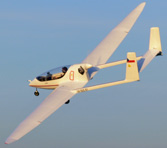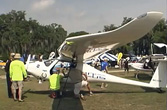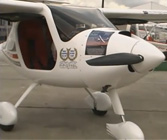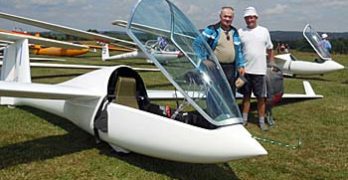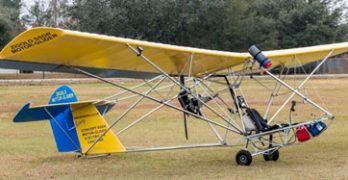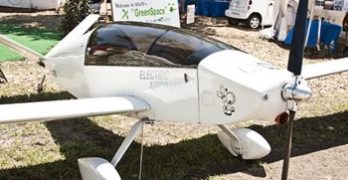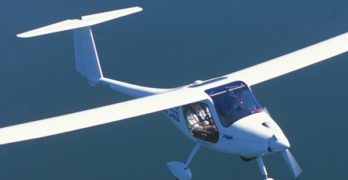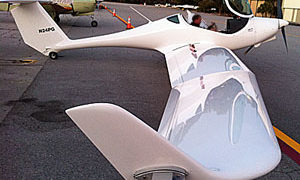We’ve seen the Song but as the ULS, a pure-electric version of the same airplane as substantially modified by Randall Fishman’s Electric Aircraft Corporation. This gasoline-powered original is offered by Melody Aircraft in Canada, represented by Gary Steadman. Song is built in the Czech Republic and imported to Canada by Gary. Listen to his advice on the video about how you can obtain one along with performance and other specs.
Search Results for : motorglider
Not finding exactly what you expected? Try our advanced search option.
Select a manufacturer to go straight to all our content about that manufacturer.
Select an aircraft model to go straight to all our content about that model.
Electric Aircraft — ULS electric motorglider (2013)
Like many of you, we began admiring this handsome motorglider at AirVenture 2012 where it made a first appearance. How could you not like these lines? After realizing this was another in Randall Fishman’s line of electric-powered aircraft, interest grew even more intense. You can watch our earlier video but in this version we find out more about flying the ULS and we see scenes of Randall flying in the new Paradise City at Sun ‘n Fun.
Pipistrel — Sinus (motorglider LSA – 04/11)
Pipistrel has a wide variety of Light-Sport Aircraft from trikes (where they started long ago) to powered sailplanes to motorgliders to more conventional fixed wing aircraft. In this video we examine the Sinus (pronounced SEEN-us) in taildragger configuration – it is also available in tricycle gear. This impressive company earned SLSA status for three models earlier in 2011 and they are moving up the sales charts.
Phoenix Air — Phoenix (motorglider)
If you love long, shapely wings, here’s an airplane to warm your heart. But it’s more than an LSA airplane… in fact, it’s a motorglider and a most impressive one at that. For soaring enthusiasts Phoenix is one of the most attractive choices among all Light-Sport Aircraft. But it can cruise fast and long while providing a huge safety measure of a very long glide in the unlikely event her engine should fail. See standard multiple wings and more in our video presentation of Phoenix.
Pipistrel — Virus (motorglider)
Pipistrel is a European producer of a family of airplanes with very smooth lines and handsome shapes. Winner of the NASA efficiency flight prize a few years ago, we have a look at the Virus (pronounced “veer-us”) that won a big check but our review can significantly apply to the Sinus (“seen-us”) motorglider. And the company also offers the Taurus, a powered sailplane… all are remarkably sleek birds in the LSA space.
Carbon Composite Part 103 Glider / Motorglider
For your weekend enjoyment — and because I am a soaring enthusiast … plus I was sent some interesting photos — consider this slick Part 103 glider, or motorglider (photo). Radek Hucik sent photos of the aircraft performing at a Czech soaring content, where it placed 12th out of 34 competitors. Considering most of the others appear to be conventional sailplanes, one that meets Part 103 at much less weight did well. A high end sailplane can hit or exceed a 50:1 glide angle. This is an amazing performance mark, which translates to flying nearly ten miles from only 1,000 feet of altitude. The XS-12 Saggita manages 35:1 (more specs below) and that is a noteworthy achievement for such a light aircraft. Radek wrote, “[This is] a powered glider that my colleagues and I have developed over the past 20 months. The glider is designed so that it meets Federal Aviation Regulations Part 103 [for] Ultralight Vehicles.
Flying the Zigolo Motorglider … a Pilot Report
For many of us, the principal reason we fly is for fun. Not to go anywhere but up, or for no other reason than that the sky is always waiting, but never impatient. Unfortunately this very pure idea became subverted along the way, as the Cubs and Champs of our forefathers were replaced by the efficient but banal 150 and PA28.
As the fun diminished the costs rose in proportion. One of the original ideas behind the whole LSA concept was affordability, but with some aircraft now priced up to $200,000 that particular principle seems to have been forgotten [though more modestly priced LSA do remain available]. Consequently, when Chip Erwin of Aeromarine LSA told me at the 2014 Sebring LSA Expo that he was bringing a new aircraft to market that required minimal assembly yet cost only $16,000 including the motor and a parachute rescue system you can bet I was interested.
Electric Motorglider For Sale
Catching up on some particulars with Randall Fishman of ElectraFlyer after our chat at Sun n Fun, he told me he’s selling his prototype C model for $49,000.
Here’s what he had to say about it and other aspects of his electric powered aircraft pioneering efforts: “We have sold trikes since 2007. Most of our sales are propulsion kits, batteries and chargers for people either building something new or converting to electric. The first two of the new motors are in my shop now and we will be mounting them for testing.
“The C is a one off conversion of a plane I already owned (a Moni kit motorglider). I want to sell it now to help finance the new projects. It is really the first successful electric airplane other than some exotic million dollar science projects such as the solar planes. I hope there is a collector out there.
Sleek, Comfortable and Fun; The Sinus Motorglider
Many Americans will agree
the name of this aircraft is odd, and that may be a kind word for the common reaction to “Sinus.” Is the name that important? Sinus (pronounced Seen-us), the aircraft, is a sleek, slender machine capable of impressive performance.
Any soaring-attuned pilot can easily live with the name Sinus for the 49-foot span and, get this, 28-to-1 glide performance! On first glance, except for its elegant, shapely, and thin wings, the Sinus looks like a proper light sport airplane. Pilot Matevz Lenarcic flew one around the world solo, in 80 days, and with zero ground or air support (see “Microlight Motorglider Flies Around the World,” April ’05 UltralightFlying! magazine).
What’s In a Name After All?
Let’s consider that name. U.S. dealer Robert Mudd says Pipistrel – the manufacturer – prefers to pronounce it “seen-us,” not “sighn-us.” They say this refers to a perfect sound wave or sine wave rather than a head cold.
The Smooth and Long of the Phoenix LSA Motorglider
Yesterday, I was again grateful for my residence at Spruce Creek Fly-In, the large airport community near Daytona Beach, Florida. Why? Because after a lucky last-minute phone call, I zipped over to the airport restaurant and went flying with Jim Lee in his new Phoenix. *** Now, I’m a soaring enthusiast, so a LSA motorglider already starts well up my wish list. But this Phoenix, whew! She’s simply gorgeous with slippery compound curves and the handling is marvelous. *** Much more than simply a soaring machine, Phoenix climbs like the proverbial homesick angel and can cruise faster than many LSA. It also comes standard with two wing configurations — 49 feet stepping down to 36 feet — so you really get two airplanes in one. (Not only that, but if you need to put Phoenix in a hangar, you can remove the long wingtips to squeeze down to a 34-foot span, hardly any wider than a “standard” LSA.) *** Inside the cockpit, the 43-inch wide space is handsomely appointed and you have a few controls and an instrument not typically found in LSA.
- « Previous Page
- 1
- 2
- 3
- 4
- …
- 23
- Next Page »


